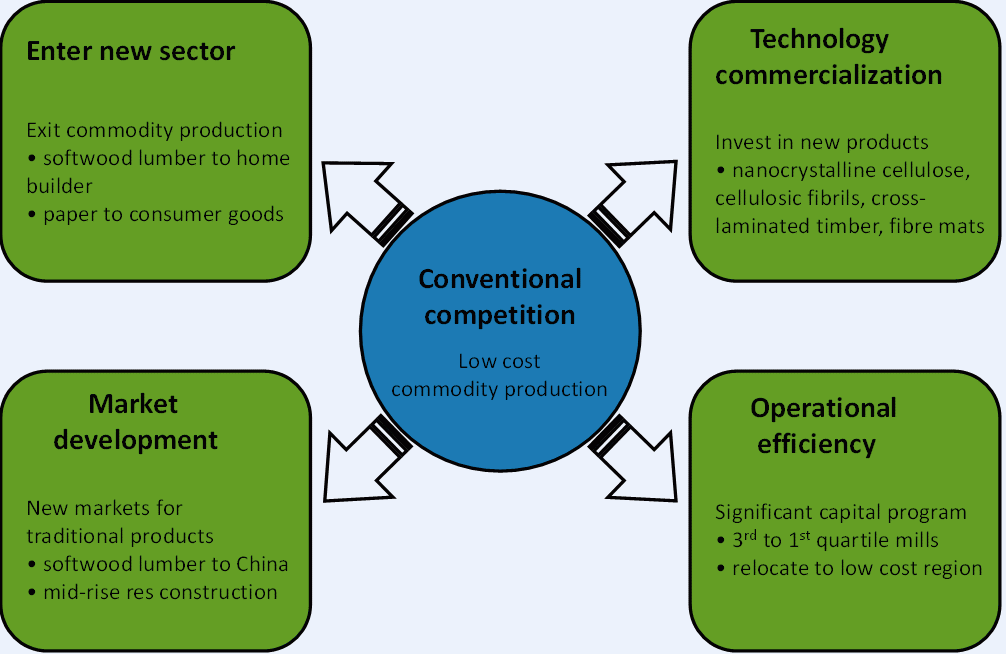Selective Cuttings
Forest sector transformation: four options for firms
July 17, 2013
Forest sector transformation is often thought of in terms of how firms can improve their strategic outlook through taking advantage of new technologies and products. However, this is only one way that firms can transform, and in fact, isn’t even the most common option that firms have utilized in the past. Four distinct firm-level transformation strategies are presented in the figure below: operational efficiency, market development, technology commercialization, and entering a new sector.
Firm-level transformation strategies
Market development: the firm is seeking to sell their pre-existing product line with new approaches, and to new consumers. For instance, a lumber manufacturer redirects a significant portion of their shipments away from U.S. markets to China, or the expansion of light frame 2x4 construction into new areas, such as residential mid-rise construction.
Operational efficiency: the firm is seeking to significantly improve their competitiveness by decreasing their costs through capital investments. Often this is through the purchase of more efficient machinery, but could be also in, for example, Information and Communication Technology (ICT) or supply chain management. It could also be a shift in the location of production, such as purchasing a mill in a lower cost region.
Enter new sector: the firm is seeking to increase revenues by reorienting the majority of operations around a distinctly different sector. For instance, an integrated paper manufacturer sells their timberlands and paper mills, repurposes existing pulp facilities from Northern Bleached Hardwood Kraft to fluff pulp, and acquires an international presence in adult incontinence products.
Technology commercialization: the firm is seeking to increase revenues through commercializing new products. For instance, a packaging firm creates R&D and intellectual property management divisions with the goal of bringing one new smart-packaging product to market every 4 years.
Importantly, there is no “hierarchy” to these strategies, no one strategy is better than another. The particular strategy (or combination of strategies) pursued by an individual firm will depend on circumstances unique to each. The degree of transformation resulting from any given strategy will depend on the resources invested therein. Furthermore, the two strategies across the top row will involve significantly more radical change to the firm, and correspondingly require a much higher degree of investment.
At the level of the sector, a sustainable and diversified sector will likely involve multiple firms pursuing each of these strategies—including many following the centre strategy of profiting within a low cost commodity production framework where the medium term outlook for their company is favourable. Due to the significant costs involved in entering a new sector or commercializing technology, the largest number of firms engaging in transformation will likely be pursuing operational efficiency and market development strategies. And given the significant risk to a firm entering into any sort of transformation, it may in fact be preferable for relatively few firms to be pursuing these strategies at any one time, as the sector could otherwise be exposed to significant risks from economic instability.
A transforming sector is not a sector in which there are no firms producing commodities. A profitable commodities sector is necessary to provide the revenues necessary for firms to fund transformation strategies. Given the realities of the capital and labour required to produce significant volumes of commodities, it is clear that in a Canadian context a transformed sector will remain one where most economic activity remains commodity focused.

